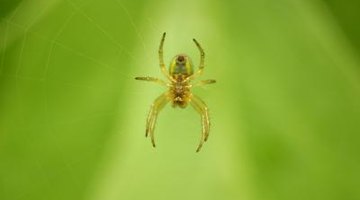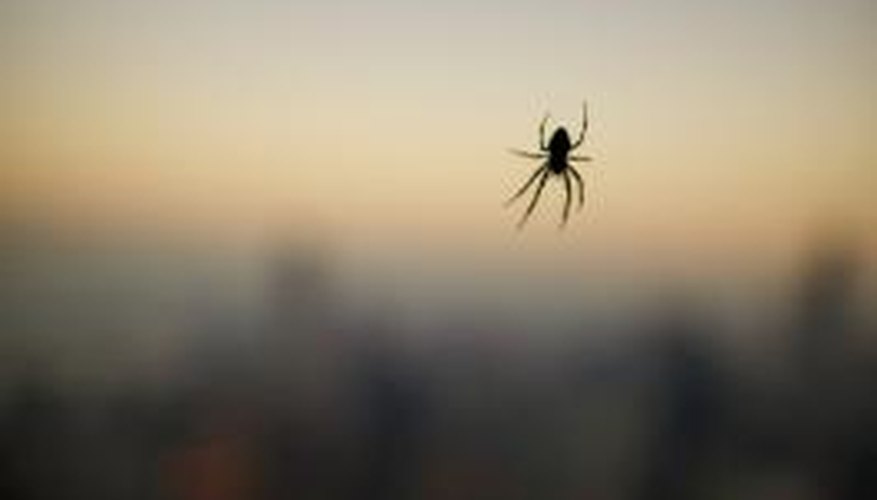Spiders are frightening, fascinating, industrious and come in an array of colours, many of which are protective colouring. The drab brownish-grey and black tarantula becomes almost invisible in dark, rocky or sandy places, while spiders of brighter hue blend in with flowers and foliage. Green spiders -- some dull and mossy, others a brilliant, arresting neon green -- often dwell among forest leaves or in a flower garden's profusion of colours.
Crab Spider

Crab spiders come in several varieties and looks. The crab spiders most people see are part of Thomisidae family. Their little bodies with the elongated front legs are often coloured in intense, neon orange, yellow or green, as well as duller colours. Flower spiders, a member of the crab spider family, also sport bright colours and some can even change their colours to blend in with whatever colour flower they are visiting. Crab spiders are not harmful to humans. They eat flies, mosquitoes and other pests and are considered a beneficial spider.
- Crab spiders come in several varieties and looks.
- Flower spiders, a member of the crab spider family, also sport bright colours and some can even change their colours to blend in with whatever colour flower they are visiting.
Green Huntsman Spider
Green huntsman spiders, also known as great huntsman spiders, are Micrommata virescens, of the family Sparassidae. Their primary habitat is in tropical locations and they have been found in areas from Asia to South America. Green huntsman spiders don't weave webs -- they live and hunt other insects among the leaves and grasses, where its colour allows it to blend in. Parts of this spider's body range from very bright green to dull brownish-black.
- Green huntsman spiders, also known as great huntsman spiders, are Micrommata virescens, of the family Sparassidae.
- Green huntsman spiders don't weave webs -- they live and hunt other insects among the leaves and grasses, where its colour allows it to blend in.
Green Lynx Spider

The green lynx spider, genus Peucetia viridans, lies in wait for its prey and then pounces, somewhat like its namesake. They can also run very fast, another similarity. Their efficient hunting skills have caused some interest in their use in agricultural pest management, as they eat harmful and crop-damaging insects. They are indiscriminate diners, however, and also eat the beneficial insects. These spiders live in green and leafy areas, on shrublike plants and among the tall grasses. They do spin webs, but they don't use them to catch prey; that they do on the ground and from the bushes, where they can leap out to capture their meal.
- The green lynx spider, genus Peucetia viridans, lies in wait for its prey and then pounces, somewhat like its namesake.
- Their efficient hunting skills have caused some interest in their use in agricultural pest management, as they eat harmful and crop-damaging insects.
Cucumber Spider
The cucumber spider is small and its large abdomen is bright green, with tiny black dots. These little critters can usually be sighted in your garden hanging upside-down in their webs. Their colour ranges from a bright, minty green to the deep green of a cucumber, with yellowish stripes. In back, just above their spinners, the cucumber green has a small, red dot. The scientific name for this colourful spider is Araniella cucurbitina, and they are of the family Araneidae.
- The cucumber spider is small and its large abdomen is bright green, with tiny black dots.
- The scientific name for this colourful spider is Araniella cucurbitina, and they are of the family Araneidae.
